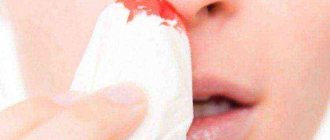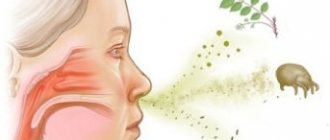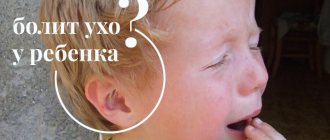Causes
Provocateurs of nosebleeds can be external factors or internal disruptions in the body. In any case, whatever the reason, it is worth blocking its effect, because blood from the nose scares the baby and affects his psycho-emotional state.
The famous pediatrician Komarovsky says that the main reason why a child’s nose bleeds is damage to the blood vessels of the mucous membrane.
Causes of nosebleeds
The risk of microtrauma increases if:
- vessels are superficially located. The baby may simply pick his nose and catch the mucous membrane with his nail or carelessly wipe his nose with a napkin. When young children put foreign objects into their noses and forget about them or deliberately hide the fact from their parents, their nose may also bleed. In some cases, a “forgotten” item can trigger an inflammatory process. Then the bloody discharge mixes with purulent discharge and has a very unpleasant odor;
- the air is not sufficiently humidified (especially in cold times, when the heating season begins). This thins the mucous membrane, it quickly dries out and the slightest damage causes bleeding;
- inflammatory processes occur in the mucous membrane. During infectious diseases accompanied by fever and runny nose, blood vessels become inflamed. Toxic substances released by pathogenic microorganisms corrode and thin their walls, causing ruptures and bleeding. Parents should know that inflammation of the mucous membrane can be caused by inhalation of tobacco smoke. For this reason, you should refrain from smoking when your baby is nearby;
- There are congenital defects of the vascular network. It is considered one of the types of varicose veins;
- Vasoconstrictor drops, some antihistamines, complex cold medications and corticosteroids were used over a long period of time. Because of this, the mucous membrane becomes thinner and the risk of bleeding increases;
- The child has a deviated nasal septum. Due to the defect, the blood vessels expand unevenly, they become more fragile and brittle;
- there was trauma to the nose or face. Please note that cranial injuries provoke very severe bleeding.
Interesting: How to treat chapped lips at home
Factors that may cause a child to have a nose bleed also include:
- deficiency of ascorbic acid, vitamin K and calcium in the body;
- increased blood pressure due to physical or emotional stress. In addition, a surge in pressure can be caused by a tumor in the adrenal glands, chronic kidney disease, pathologies of the heart muscle, atherosclerosis or hypertension in the development stage;
- poor blood clotting. Bleeding can also be caused by blood cancer or disorders of the hematopoietic function of the brain, low concentration of platelets or white blood cells;
- cirrhosis of the liver;
- constant headaches;
- nervous disorders;
- in girls - during puberty during hormonal changes in the body;
- atrophic rhinitis;
- overheating of the body.
How to behave
The reasons that cause a child to bleed from the nose at night are similar to those described above. It is not necessary to touch the nose for mechanical damage.
If dried mucus has accumulated, bleeding can trigger normal sneezing.
Causes of nosebleeds in children
Often parents worry about a problem without understanding why it happened. Nosebleeds in children have different causes. They are usually divided into two main types. The first, local reasons include:
- head and nose injuries (fractures, etc.);
- minor damage to the nasal mucosa, for example, after picking;
- improper development of blood vessels;
- deviated septum, which is hereditary;
- tumors, polyps and other pathologies;
- consequences of mucosal injuries caused by operations: probing, etc.;
- inhalation of small particles, insects, and parasites (worms);
- some diseases: sinusitis, vasculitis, etc.
Common reasons include:
- Vascular tone disorders, such as high blood pressure.
- Blood diseases.
- Fragility of blood vessels, which is caused by: infectious diseases with fever (flu, etc.), vasculitis, lack of essential vitamins, minerals in baby food: C, K, Ca and more.
- Taking certain medications that have a thinning effect.
- Dry air in the room: the mucous membrane dries out, blood vessels are easily damaged.
- Sometimes - radiation, harmful fumes, etc.
Sinusitis
Bleeding is often caused by sinusitis, an inflammation of the nasal mucosa in the paranasal sinuses. It usually appears if ventilation is disrupted and germs find themselves in a closed space. For example, with normal symptoms of a runny nose, sinusitis can become a complication.
Read also: Bleeding from the gastrointestinal tract
To completely get rid of bleeding, you need to eliminate its cause. Sinusitis occurs in acute and chronic forms and can affect several sinuses. The appearance is influenced by weakened immunity or improper, incomplete treatment of the pathologies that cause it:
- ARVI;
- tonsillitis;
- adenoiditis;
- injuries;
- polyps and other formations;
- advanced dental damage, etc.
Blood diseases
Blood diseases also need to be excluded during diagnosis. Age should be taken into account: the younger it is, the harder it is for the child, and additional symptoms may appear. Common disorders that cause nosebleeds in children include:
- disorders related to blood clotting: hemophilia, hemorrhagic diathesis;
- a significant decrease in white blood cells (agranulocytosis);
- decreased platelet count (Werlhof's disease);
- leukemia
Vasculitis
Vasculitis is a violation of the integrity of the walls of blood vessels. This is a group of diseases that affect various parts and systems of the body: legs, arms, lungs, kidneys, etc.
It is necessary to check the condition of the blood vessels, whether there is a rash. This is important not only to eliminate unpleasant symptoms. Damage to the nasal vessels is sometimes almost the only manifestation of some serious diseases.
Vasculitis Wegener's granulomatosis is an inflammation of the vessels of the nasal cavity and its sinuses. Violation of the integrity of the walls is caused by the development of granulomas. Many people are unaware of the disease until severe consequences appear: the lungs and kidneys are affected. In the early stages it is only nasal congestion and bleeding.
Pathologies of vascular tone regulation
A common cause is increased blood pressure. This occurs when larger vessels in the body cannot properly regulate blood flow, and small ones burst. Violations result from:
- hypertension;
- heart pathologies, for example, defects;
- vegetative-vascular dystonia;
- lung disorders: pneumosclerosis;
- tension as a result of physical effort, stress;
- kidney diseases.
When you need a specialist
It must be taken into account that the discharge can be from the anterior or posterior part of the nose. In the first case, blood comes out of only one nostril. The second type is extremely rare. Blood comes from both nostrils, there is a lot of it and it is difficult to stop. In this case, you should immediately consult a doctor.
The child also needs to be shown to a specialist if it was not possible to stop the bleeding within 20 minutes, the bleeding recurs regularly over a long period of time, or the child suffers from diabetes.
Take your child to the pediatrician
Be sure to consult a doctor if your nosebleed is accompanied by other types of bleeding. For example, from the mouth, ear, gums or genitals. If you experience hemoptysis, vomiting with blood or the color of coffee grounds.
After any injury that provoked bleeding, in case of hemophilia, if the baby lost consciousness or the blood became foamy, it is necessary to call an ambulance.
Helping a child with nosebleeds
Anterior nosebleeds stop almost immediately and almost on their own. But still some manipulations are required:
- calm the child down, sit him on a chair, and pick up the little ones;
- unbutton clothes, try to let the child inhale through the nose and exhale through the mouth;
- feet should be warm;
- tilt your head slightly forward and pinch your nostrils with your fingers;
- throw back your head, but be sure to put cold on the bridge of your nose and insert a tampon into your nose;
- put cold on the back of your head;
- make a small swab from cotton wool or a bandage, moisten it in a 3% solution of hydrogen peroxide or in vasoconstrictor drops and insert it into the nostril;
- if there is no hydrogen peroxide, drip vasoconstrictor drops into the nose - Galazolin, Naphthyzin, Rinazolin or 0.1% adrenaline solution;
- if the bleeding continues, then after 10-15 minutes you need to call an ambulance.
Then, twice a day, lubricate the nasal mucosa with Vaseline (or Neomycin, Bacitracin ointment) to prevent it from drying out again and to promote better healing, which can last from 1 to 5 weeks.
If the air in the apartment is dry, especially during the heating season, it is recommended for the child to instill sea water-based products - Salin or Aquamaris - into the nose.
After stopping the bleeding, the child must be shown to an ENT doctor to prevent recurrences. He will examine the baby, if necessary, he will cauterize the bleeding area, and if necessary, he will send him for a full examination to find out the reasons.
If there is bleeding, you should not:
- blow your nose, this will dislodge the clot that forms, and the blood will flow again;
- throw your head back, as blood will flow down the back wall of the throat, enter the stomach or block the airways; in the first case, vomiting may occur, and in the second, suffocation;
- if the cause of bleeding is a foreign body, you cannot remove it yourself, as it can become dislodged and cause suffocation.
Indications for calling an ambulance:
- bleeding does not stop within 15-20 minutes;
- there has been a head injury, after which blood comes from the nose along with a clear liquid (suspicion of a fracture of the base of the skull);
- intense bleeding, blood flows out in a stream, a clot does not form;
- there is hemoptysis (posterior bleeding) or vomiting of blood (bleeding from the esophagus);
- foamy blood (pulmonary hemorrhage);
- in addition to bleeding, vomit the color of coffee grounds occurs, which indicates gastric bleeding;
- the child (teenager) often has high blood pressure;
- a child whose nose is bleeding suffers from diabetes;
- the baby fainted;
- a small patient receives drugs that reduce blood clotting - Aspirin, Indomethacin, Ibuprofen, Heparin, etc.;
- the child has hemophilia or other diseases affecting the blood clotting mechanism.
Medical assistance
To stop intense nosebleeds, an ENT doctor can take the following measures:
- anterior or posterior tamponade impregnated with a 1% solution of feracryl, preserved amnion, epsilon-aminocaproic acid;
- remove a foreign body or polyps if they appear and cause nosebleeds;
- insertion of a tampon with trichloroacetic acid or vagotil, which cauterizes the vessels, thus stopping bleeding;
- coagulation (cauterization) of the bleeding area of the mucosa using one of the following methods: laser, ultrasound, electric current, liquid nitrogen, silver nitrate, chromic acid;
- use of a hemostatic sponge in the nasal cavity;
- in case of heavy blood loss - transfusion of donor blood, fresh frozen plasma, intravenous administration of rheopolyglucin, hemodez and aminocaproic acid;
- if the measures taken are ineffective, surgical intervention is indicated - ligation or embolization (blockage) of large vessels that supply blood to the problem area of the nasal mucosa;
- endoscopic cryodestruction;
- administration of sclerosing drugs, oil solution of vitamin A;
- oral administration of drugs that increase blood clotting - calcium chloride, Vikasol, ascorbic acid, calcium gluconate.
In case of intense bleeding or massive blood loss, the child must be hospitalized in the ENT department.
After a nosebleed, children should not exercise for several days or consume hot drinks or foods. This causes a rush of blood and lymph to the head, which can cause bleeding again.
Who to contact
If your child has a nose bleed and the cause is unknown, it is important to know which doctor to contact. First of all, you need to visit a local pediatrician who has information about his state of health and the presence or absence of chronic diseases.
Your pediatrician will be able to measure your blood pressure and prescribe home monitoring. To do this, parents will have to take measurements three times a day for 14 days and record the results. This will help exclude or confirm hypertension.
The doctor will prescribe a general blood test and a coagulogram. This is a comprehensive analysis of blood clotting indicators, which also shows the likelihood of bleeding or blood clots. After receiving the results, you may need to consult a hematologist.
If bleeding is frequent, the child should be examined
For a complete clinical picture, you will need to do a biochemical blood test. It will help assess the functioning of internal organs and metabolic processes, as well as the need of the child’s body for microelements.
It would be a good idea to show the child to an otolaryngologist. He will be able to assess the condition of the vessels in the nose. An X-ray will help identify polyps or purulent inflammation of the maxillary sinuses.
The neurologist, in turn, will check the intracranial pressure.
An allergist will confirm or deny the presence of an allergy, due to which the vessels in the nose overflow with blood, cannot withstand pressure and burst.
With a teenage girl, you need to visit a gynecologist and endocrinologist. In the female body, before the onset of menstruation, the blood supply increases not only to the genital organs, but also to the tissues of the nose, which are absolutely identical. As a result, the vessels become overfilled with blood and, unable to withstand the additional pressure, burst.
When the menstrual cycle normalizes and becomes regular, these problems go away. But, in any case, a consultation would not hurt.
If bleeding occurs during exercise or is accompanied by chest pain or dizziness, you should consult a pulmonologist or cardiologist.
In very rare cases, nasal discharge is a sign of cancer, so when other causes have been ruled out, it is necessary to consult an oncologist.
Emergency help
When a child has a nosebleed, regardless of the cause, it is important to know how to stop the flow. There is a certain algorithm of actions that must be followed:
- sit the child on a chair, tilt his shoulders slightly forward. The head should be slightly lowered;
- Gently squeeze the wings of the nose just under the bone. The pressure should not be strong, continuous and last 10 minutes. During this time, a blood clot forms and blocks the damaged vessel. There is no need to check whether the bleeding has stopped or not. Constant pressure and release may cause more intense flow;
- apply cold to the bridge of the nose;
- Constantly rinse your mouth with cold water.
First aid for nosebleeds
During assistance, the child should sit quietly, not talk, not cough, not blow his nose, not pick his nose, and not swallow blood. You can have calming conversations with him so that the baby stops panicking. Due to anxiety, the heart rate increases, and, accordingly, the speed of blood flow and the intensity of bleeding increase.
If after 10 minutes the bleeding has not stopped, the cycle must be repeated. Expiration lasting more than 20 minutes requires immediate attention to the clinic.
After the bleeding has stopped, the child should, if possible, breathe only through his mouth for about an hour. Any physical activity is prohibited.
How to stop correctly at home?
The sight of blood scares children, and some parents too. Therefore, first you should calm down, act without fuss and confidently.
Here's how to stop a child's nosebleeds at home:
- Have the teenager sit on a chair and take the baby in your arms. Keep your head straight or slightly tilted forward.
- Squeeze the wings of the nose with your fingers (or one nostril if the bleeding is one-sided). If there is a cloth napkin or scarf nearby, use it. Breathing comes through the mouth.
- Keep your nose pinched for ten minutes. Then let go and see if the bleeding has stopped. If it still goes on, press it again and hold it for another ten minutes. You should not let go of your nose sooner than ten minutes later. The resulting clot may break off and the bleeding will start again.
- If the child is old enough to squeeze his nose on his own, then it is worth using a cold compress. To do this, you can bring something from the freezer, wrap it in a cloth and place it on the bridge of your nose. Keep the compress for a maximum of ten minutes.
- While the bleeding stops, you need to calm the child down and talk to him. If possible, distract with an interesting toy, book, or cartoons.
It is imperative to calm the child
When providing assistance, it is important not to harm the child. You need to firmly understand what not to do:
- Throw your head back. In this case, blood flows down the back of the throat, and there is a chance that it will enter the esophagus or larynx. This is bad for several reasons. First, it is difficult to estimate the amount of blood. Secondly, the child will experience nausea and may start vomiting. And the most dangerous thing is that blood can get into the breathing tube and block the access of air to the lungs.
- Blowing your nose or pulling blood clots out of your nostril.
- Put to bed. In order for the bleeding to stop, the head must be higher than the body.
- Cough.
- Insert dry cotton swabs into your nose. When a dry swab is removed, the frozen crust comes off, and the bleeding will have to be stopped again.
- Talk, move actively.
Errors
Many parents, not knowing the reasons why their child is bleeding from the nose, panic and do not know what to do. Because of this, when providing emergency assistance, they make mistakes that can aggravate the condition of their beloved child:
- You cannot put him in a horizontal position or ask him to throw his head back. In this position, the child will reflexively swallow blood, which contributes to severe nausea and vomiting;
- You cannot carry out tamponade on your own, without special training. Putting tampons into your nose can further damage the mucous membrane, which can worsen bleeding. In addition, the blood, soaking the cotton wool, will gradually become thicker and dry to the mucous membrane. When the parent tries to remove the tampon, bleeding may resume;
- no need to ask your baby to blow his nose. Because of this, a blood clot that forms at the site of a ruptured vessel and blocks the outflow can come off;
- When your nose is bleeding, you need to talk to your child, but not try to get an answer from him. He must sit silently, absolutely motionless.
What not to do
Treatment
The majority of childhood nosebleeds occur due to damage to blood vessels in the nose. Treatment is to stop the flow and prevent relapse.
The specialist can perform an anterior or posterior tamponade, causing compression of the vessels, which leads to stopping the bleeding. A burst vessel can also be cauterized with liquid nitrogen or a laser.
If measures to stop the bleeding are ineffective, surgical intervention is indicated.
When the reason why a child’s nose is bleeding is established, the question arises of how to treat it.
If the bleeding was profuse, administration of calcium chloride, calcium gluconate, Vikasol and red blood cells is prescribed. An oxygen mask may also be placed on the child.
Nosebleeds can be a symptom of various diseases.
To strengthen the vascular walls, doctors prescribe Ascorutin.
If the bleeding was caused by diseases of the internal organs, appropriate medical therapy is prescribed.
A child often has nosebleeds, treatment with folk remedies
Nosebleeds (epistaxis) in a child is a pathology that can frighten not only the baby himself, but also the parents. Basically, this condition does not cause concern, but there are serious situations. Every mother should have an idea of why a child’s nose bleeds, the reasons that provoked the problem, and situations in which it is necessary to urgently go to the hospital.
Prevention
When bleeding is sporadic, the baby does not complain of general malaise, and all tests are normal, preventive measures will be sufficient:
- to prevent the nasal mucosa from drying out, you need to maintain a temperature of 18°C-20°C and a humidity of 50-70% in the child’s room;
- during acute respiratory infections, it is necessary to moisturize the mucous membrane, for example with saline;
- diversify your diet with fruits and vegetables. In the off-season, take a course of multivitamins;
- teach proper hygiene, do not allow nose picking;
- eliminate mental and physical stress.
A healthy lifestyle can prevent recurrent bleeding if it is not the cause of a serious illness. In any case, to ensure the health of the child, a consultation with a pediatrician is necessary.
Causes of nosebleeds
Before undertaking treatment, it is necessary to determine what caused the bleeding. The method of treatment and further precautions will depend on this.
The following are the causes of nosebleeds:
- Vegetovascular dystonia. It appears due to weather changes. The vessels either expand or contract. Thin walls burst. The appearance of nosebleeds is preceded by a headache and a peculiar ringing in the ears.
- Lack of vitamin K. Poor blood clotting is caused by a lack of this particular vitamin.
- Lack of vitamin C. Lack of vitamin C leads to increased fragility of blood vessels and their rapid destruction.
- Mechanical injuries. Simply blowing your nose or cleansing your nose leads to the destruction of delicate blood vessels.
- Polyps in the nasal cavity. Their active growth in the nasal cavity leads to frequent bleeding, especially in the morning. Once it stops and heals, careless mechanical movements can cause new injuries and further bleeding.
- Insufficient blood clotting. When taking blood thinning medications, the blood practically does not clot and can leak for almost no reason.
- Drying of the nasal mucosa under the influence of cold and high temperatures.
- Hormonal changes. The causes of nosebleeds lie in the puberty of girls. The tissues of the nasal cavity are similar in structure to the tissues of the genital organs. As a result, replacement bleeding occurs. As soon as the menstrual cycle returns to normal, bleeding from the nasal cavity will stop.
- Overheating. Under the influence of elevated temperatures during illness. In the summer due to sunstroke and simple overheating of the head.
- Overwork and stress. Such causes of nosebleeds are typical for people during exams, reports, and constant sitting at the desk studying papers and textbooks. Stress, overwork and lack of air lead to worsening of the condition and bleeding.
- Pressure changes due to diving to depths or climbing mountains.










